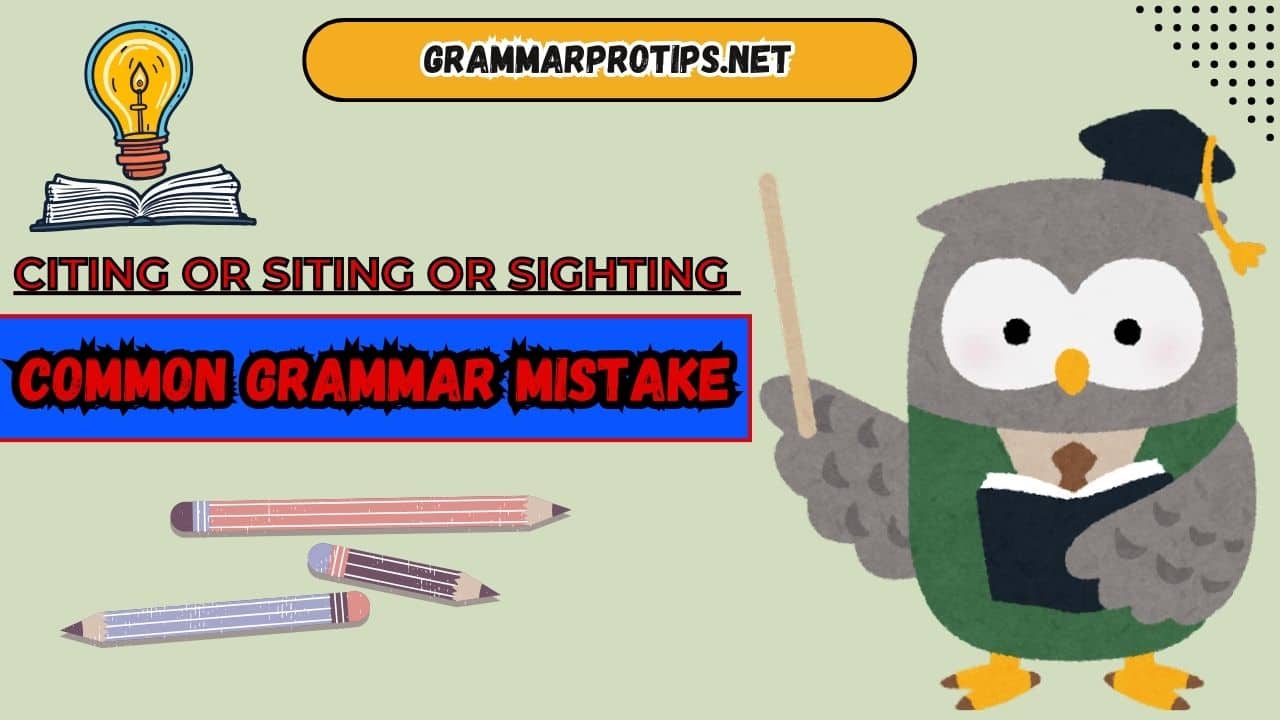English can be tricky, especially when it comes to words that sound alike but have very different meanings. Citing, siting, and sighting are prime examples of this, and getting them wrong can lead to confusion.
Understanding when and how to use each term is crucial, especially in professional, academic, and everyday contexts.
In this article, we’ll break down each term’s meaning and usage, provide practical examples, and even offer a handy table to help you quickly understand the differences.
Let’s dive into how to avoid these common grammar mistakes and make your writing clearer and more effective.
What Do Citing, Siting, and Sighting Mean?
Though these three words look similar, their meanings are entirely different. Here’s what you need to know:
Citing: Referencing or Quoting Sources
When you cite something, you’re acknowledging a source, whether it’s an academic article, a legal case, or even a casual reference.
Citing is essential for proper source attribution and plagiarism prevention. It’s a formal practice used in research papers, legal citations, or any scenario where you need to show where you got your information from.
Examples:
- “Remember to cite your sources to avoid plagiarism.”
- “The professor emphasized quoting sources correctly in the research paper references.”
- “I need to create a reference list in APA citation style.”
Siting: Selecting a Location
Siting refers to the process of choosing or designating a location for something, especially in construction, architecture, or urban planning.
Whether you’re planning where to place a new building, selecting a construction site, or evaluating property zoning, siting is the term you’ll use.
Examples:
- “The architects spent weeks siting the building to ensure it’s in the optimal location.”
- “Our team is currently conducting a site orientation to determine the best place for the new school.”
- “The engineers are reviewing the environmental impact assessment of the chosen site.”
Sighting: Observing Something
A sighting refers to the act of seeing or observing something, often something noteworthy, rare, or unusual.
Whether it’s wildlife observation, celebrity sightings, or a paranormal sighting, this word is all about what you see or spot.
Examples:
- “There was a rare sighting of an endangered owl in the forest.”
- “I had an exciting sighting of a famous actor at the café.”
- “The sighting of the comet was reported by amateur astronomers.”
When to Use Citing, Siting, or Sighting: Key Differences at a Glance
To make it easier to remember when to use each term, let’s take a look at this helpful table that summarizes the differences.
| Word | Meaning | Contexts / Examples |
|---|---|---|
| Citing | Quoting or referencing a source | Academic work, legal documents, research paper references, citation practices. |
| Siting | Selecting or designating a location for something | Construction site selection, urban planning, site development, environmental impact assessments. |
| Sighting | Observing or seeing something, often rare or unusual | Wildlife observation, celebrity sightings, unusual events, paranormal sightings. |
Common Mistakes and How to Avoid Them
Mistake #1: Mixing up “Citing” and “Siting”
Since citing and siting are similar in sound, it’s easy to mix them up. However, one is about referencing sources and the other is about selecting locations. Here’s how to keep them straight:
- Use citing when you are quoting sources or referencing information.
- Use siting when you’re determining a location for something (like a building or project).
Correct Usage:
- “The researcher is citing relevant studies to support her argument.”
- “The city is siting a new park in the downtown area.”
Mistake #2: Confusing “Siting” and “Sighting”
Another common mistake is confusing siting (location planning) with sighting (seeing or observing something). To avoid this mistake, just remember that siting involves choosing a location, while sighting is about observing something.
Correct Usage:
- “The construction team is siting the new headquarters.”
- “I had a sighting of a rare bird during my hike.”
Mistake #3: Using the Wrong Form
While citing and sighting can be pluralized (i.e., citings and sightings), siting is typically not pluralized. When you see these terms in a sentence, check to see if the plural form is appropriate.
Correct Plural Usage:
- “The study contains multiple citings of earlier research.”
- “There have been several sightings of the rare bird recently.”
However, sitings is rarely used unless in specialized contexts.
Examples in Context: Using Citing, Siting, and Sighting
To clarify further, let’s look at some example sentences for each word.
Citing in a Sentence:
- “To avoid plagiarism, the student ensured he was citing his sources properly in the reference list.”
- “The paper includes extensive quoting sources from credible academic journals, following MLA format.”
- “In legal citations, it’s important to cite court cases accurately to maintain credibility.”
Siting in a Sentence:
- “The team is currently siting the new office building on the corner of Main and Oak streets.”
- “Proper site orientation is essential to ensure that the new factory is positioned away from flood-prone areas.”
- “Urban planners are siting green spaces within the city’s expanding neighborhoods to enhance quality of life.”
Sighting in a Sentence:
- “We had an unforgettable sighting of a mountain lion during our hike through the forest.”
- “The sighting of an unidentified flying object has sparked rumors of a paranormal sighting in the area.”
- “Fans were thrilled by the unexpected sighting of their favorite celebrity at the event.”
Conclusion: Choosing the Right Word
To wrap up, here’s a quick recap of when to use each of these words:
- Citing refers to referencing or quoting sources in academic, legal, or professional contexts. It’s about giving proper credit.
- Siting is about choosing a location for a project, building, or development.
- Sighting is about seeing or observing something, often something rare, unusual, or noteworthy.
By keeping these distinctions in mind, you can confidently use the correct term, whether you’re working on a research paper, planning a construction site, or sharing an exciting wildlife observation.
Understanding these subtle differences will improve your writing clarity and prevent confusion in your communication.
Read more knowledgeable blogs on Grammar Pro Tips

Sienna Mauldon is a passionate writer and grammar expert. On her blog, she shares easy-to-follow guides to help readers master grammar rules and improve their writing. With a love for language and teaching, Sienna makes grammar simple and fun for everyone, from beginners to experienced writers.








